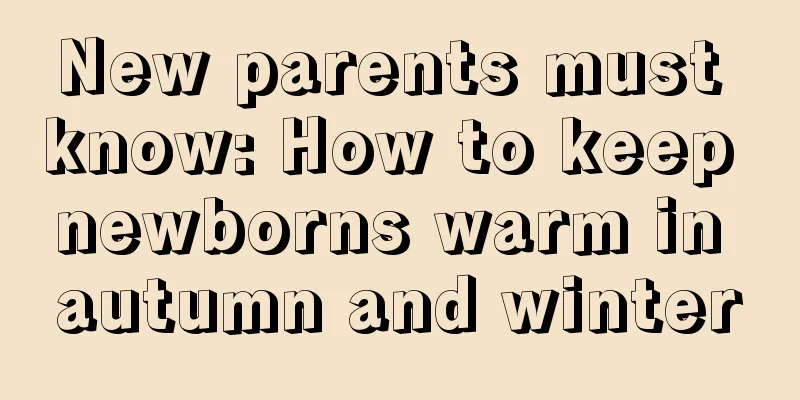New parents must know: How to keep newborns warm in autumn and winter

|
How to keep newborn babies warm in the cold autumn? New parents must not know the right balance. They can neither cover them nor let them freeze. What should they do? In order to ensure that newborn babies spend their first autumn safely, the following editor will give new parents some tips. How to keep newborns warm in autumn and winter1. Ambient temperature In the cold autumn, the room temperature of the newborn should generally be maintained at 20-24 degrees Celsius. The autumn and winter are relatively dry, and attention should also be paid to the indoor humidity, which should generally be maintained at around 50%. A humidifier can be used to increase the indoor humidity. 2. Baby's clothes and quilts It is best to use new cotton and soft and comfortable cotton cloth to make baby's clothes and quilts. To ensure good warmth retention. Pre-warm the baby on a heater or stove before wearing and wrapping. Do not wrap too tightly to avoid affecting the baby's limbs. If the warmth is not enough, add a blanket or use a hot water bottle to keep warm. However, special attention should be paid to the water temperature in the water bag, which should be around 40-60℃, and the hot water bag cap must be tightened. Place the hot water bottle outside the blanket and do not stick it directly to the skin to prevent scalding the baby. 3. Changing baby's diaper Newborns urinate frequently and need to have their diapers changed frequently. Since the temperature of the diaper is lower than the temperature of the baby's abdomen, be careful not to place the diaper on the baby's abdomen to prevent the abdomen from getting cold. If conditions permit, pre-warm the diaper on the heater before changing it. 4.Baby bath When the ambient temperature is low, do not put your baby in the bathtub to bathe him, wash him part by part. After washing, wipe dry with a dry towel, put on a small cloth cap, then wash the neck, armpits, and elbows. When the upper body is washed, put on a shirt or wrap it with a bath towel, then wash the groin, buttocks, lower limbs, and clean the baby's private parts with running water. After washing, do not let the baby sleep immediately, as it is easy to catch a cold. It is best to move with the baby. Do not feed the baby immediately. When bathing, the blood vessels in the skin are congested, the blood is redistributed, and the gastrointestinal tract is in an ischemic state. Feeding the baby immediately is not conducive to digestion and absorption. In addition, please note that there should be no air convection around when bathing. The indoor temperature should be above 24℃. Take a bath 2 hours after feeding to avoid milk spillage. 5. Use a sleeping bag Babies tend to be more active when they sleep at night. Parents should check their babies at all times and be careful not to let their heads and faces fall under the quilt, which may cause suffocation. Using a sleeping bag can not only keep them warm, but also solve this problem. 6. Keep warm when going out When the weather is not particularly cold, you can take your baby out more often to get some fresh air. Wear thicker clothes when going out, and wrap your baby in a blanket if necessary. Also, make sure your baby's head, ears, and hands are covered to prevent the wind from blowing and causing skin cracks. Outdoors, if you want to take your baby out of the car, be sure to cover the baby's mouth and nose with clothing or a thin blanket, because the baby's nasal mucosa is rich in blood vessels and the nasal cavity is relatively narrow. When exposed to cold wind, the nasal mucosa is easily congested, causing nasal congestion. Three Misconceptions about Keeping Newborns Warm1. Judging whether it is cold or not by the temperature of your hands Many parents often touch their children's hands to judge whether their clothes are appropriate. In fact, this is not appropriate in autumn. Because hands are exposed to the outside for a long time, they are naturally easy to get cold. Even if you put three layers of clothes on your child, the child's hands may still be cold even if he sweats. If parents make a wrong judgment, it may cause the child to catch a cold and be more likely to catch a cold. 2. Wrap your child in a candle bag Wrapping babies in a "candle wrap" with several layers of clothing, cotton cloth, blankets, or even using ropes to secure the body not only restricts the child's movements, but also easily compresses the child's chest, restricts breathing, and affects lung growth and development. Parents are advised to dress babies in loose clothing. 3. Indoor air conditioning temperature is too high Some parents use air conditioning to set the room temperature to around 30 degrees, while the outdoor temperature is often only a few degrees. With such a huge temperature difference, children are prone to getting sick when going in and out of the house. If the baby is dressed warmly, it is recommended that parents control the air conditioning temperature to around 20 degrees and pay attention to regular ventilation. How to keep your baby warm in winterIt is very common to use heating products to keep warm in winter, but if these heating products are used improperly, they will become "warmth killers" and harm the baby. Therefore, mothers are advised to use them less for their babies. The following 4 types of heating products should be used with caution: 1. Hot water bottle Danger factor: ★★★★☆ In fact, whether it is a traditional hot water bottle or an electric hot water bottle, it should be used with caution, because the hot water bottle is in direct contact with the body. If the lid is suddenly loosened during use, the hot water will flow out and scald the baby. It is even more dangerous if a short circuit occurs or an explosion occurs in the middle. 2. Electric blanket Danger factor: ★★★★☆ Electric blankets are contact-type electric heating devices. Although they have good insulation and can generate heat as soon as they are powered on, long-term use and continuous heating will cause a large amount of moisture loss from the baby's skin. If the baby is covered tightly and the heat is not dissipated well, symptoms of "heat stroke" will appear in winter. In addition, the heat from electric blankets will irritate the baby's skin, causing redness, itching and other discomforts. 3. Heater Danger factor: ★★★★☆ The bathroom heater raises the indoor temperature through the heat radiation of infrared bulbs. It will produce strong light when in use. If the strong light shines directly into the baby's eyes for a long time, it will cause damage to the baby's retina. In severe cases, it may even damage the baby's eyesight, making it difficult for the baby to reach normal vision. 4. Heater Danger factor: ★★★☆☆ The hot air from the heater is very hot. If the baby gets too close, he or she may get burned. In addition, frequent use of the heater will make the indoor air dry, causing the baby's throat to become dry. The harm of over-warming babies in winterMany mothers make the same mistake of dressing their babies in too many clothes, making them look like "steamed dumplings" with three layers of clothes inside and three layers outside. In fact, this can easily induce "heatstroke syndrome". So what is "heatstroke syndrome"? How to prevent it? "Muffling syndrome" is also known as blanket hypoxia syndrome. It is one of the common emergencies in winter. It is more common in infants under one year old. The main cause of the disease is that the baby wears too many clothes and stays in a warm state for a long time. The body temperature continues to rise, and there are symptoms such as high fever, sweating, dehydration, pale face, etc. In severe cases, there are even symptoms of hypoxia and nerve damage, which may also leave sequelae such as epilepsy, cerebral palsy, blindness, aphasia, etc. Therefore, prevention is necessary. To prevent "sweating syndrome", you need to know the right amount of clothes to wear when dressing your baby in winter. It is recommended to observe the baby's two parts to understand the baby's temperature and reduce the amount of clothes appropriately. If the baby's palms and back are warm, it means the clothes are appropriate, and do not wrap the baby too tightly. If the baby's palms and back sweat a lot, it means the baby is wearing too much and needs to take off some clothes. |
<<: What are the white spots in the newborn's mouth?
>>: How long can a newborn baby have his hair cut and shaved?
Recommend
Does painless childbirth have any effect on the baby? Does painless childbirth have any side effects?
Many people must have heard of painless childbirt...
How and when did you start preparing for pregnancy?
For a new mother, having a healthy baby is the ha...
What are the benefits of babies learning to paint? How to teach babies to paint
There are many benefits to letting young children...
How to treat insufficient milk after childbirth? Five treatment methods for you to choose
The most embarrassing thing about feeding a baby ...
What do expectant mothers need to prepare? A guide to stocking up for new mothers
New mothers no longer need to worry about what to...
Is Colgate mouthwash good? The correct way to use Colgate mouthwash
We have always trusted Colgate products. I want t...
What is the reason for frequent spitting up of milk in babies? Is frequent spitting up of milk in babies due to indigestion?
It is normal for babies to spit up milk. Many bab...
How to treat children's teeth grinding? What to do if children grind their teeth?
It is a common phenomenon that babies like to gri...
Can children eat durian? Can children eat durian?
Because durian has a very high edible value, many...
How long does it take for lochia to be discharged after a caesarean section? How long does it take for lochia to be discharged after a caesarean section to be considered normal?
Generally, after giving birth, pregnant women wil...
How about Zhenshiming Little Yellow Duck Eyewash? Is Zhenshiming Little Yellow Duck Eyewash safe?
Recently, I see that many people are using Zhensh...
Can a humidifier purify the air? Can a humidifier heat water?
It is not recommended to place a humidifier at th...
Which Blue Moon laundry detergent is the best? Can Blue Moon laundry detergent kill bacteria?
Blue Moon laundry detergent is quite common in th...
What are the ways to protect children's eyes? Tips for protecting children's eyes
Eyes are the windows to the soul, so we need to t...
How to use femfresh care solution, gentle and non-irritating care solution
Femfresh care solution is a care solution that ca...









